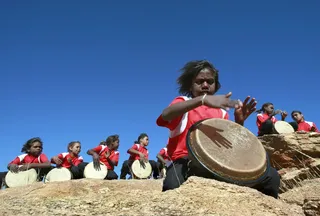Black Like Me: Australia’s Aborigines
The original Aussies are making moves Down Under.

1 / 12
Australia’s Aborigines - Although Australia’s Aborigines were there before Europeans, today they make up just 2 percent of the country’s population. As Aborigines and indigenous people become a more powerful force in the halls of parliament, mainstream media and other parts of society, BET.com takes a look at the original Australians. — Naeesa Aziz (Photo: Ian Waldie/Getty Images)

2 / 12
Who Are Australia’s Aborigines? - Aborigines or indigenous Australians are the brown-skinned people who lived on mainland Australia and the Torres Strait Islands centuries before European settlers arrived. (Photo: REUTERS/Tim Wimborne /Landov)
Photo By Photo: REUTERS/Tim Wimborne /Landov

3 / 12
Original Africans? - In 2011, after analyzing Aborigine hair collected by a British anthropologist more than a century ago, scientists concluded that the Aborigines are direct descendants of the first modern humans to leave Africa nearly 50,000 years ago. (Photo: Hulton Archive/Getty Images)

4 / 12
Black Power - Regardless of differences in skin color, many Aborigines refer to themselves as Black. Many aligned themselves with the Black Power movement of the late 1960s, adapting the ideology to their local plight. “The Australian version of Black Power, like its American counterpart, was essentially about the necessity for Black people to define the world in their own terms, and to seek self-determination without white interference,” said Australian activist Gary Foley. (Photo: Patrick Riviere/Getty Images)

5 / 12
The Block Is Hot in Australia, Too - An infamous Aboriginal housing project nicknamed “the Block” in Redfern, a suburb of Sydney, was the site of 2004 riots over the death of 17-year-old Thomas Hickey, an Aboriginal boy who was killed after being impaled on a fence while fleeing from police. The Block was also the site of riots in the 1970s over forced evictions of Aboriginal residents. (Photo: GREG WOOD/AFP/Getty Images)
ADVERTISEMENT

6 / 12
What Is Life Like for Aborigines Today? - Although Aborigines can be found in all facets of Australian life, due to centuries of discrimination and marginalization, they are the poorest ethnic group in Australia. The gap between white Australians and Aborigines in the areas of health and education is staggering, and a disproportionate number of Aborigines are imprisoned. (Photo: REUTERS/UNAMID/Albert Gonzalez Farran/Handout)

7 / 12
Northern Territory Victory - In March 2013, Adam Giles was sworn in as the first Aboriginal leader of a provincial government. Giles will lead Australia’s Northern Territory where Aborigines make up 30 percent of the population."Moms and dads can say: 'You can do it. You can do anything. Look at Giles. If he can do it, you can do it,'" he told reporters after he and his cabinet were sworn in. (Photo: Adam Giles/Facebook)

8 / 12
Nova’s Got Next? - Earlier this year, Australian Prime Minister Julia Gilliard used her political weight to get her party to make Nova Peris, an Aborigine and Olympic gold medalist hockey player, their first choice for Northern Territory senator. If elected, Peris will be the first Aboriginal woman to serve in Australia’s Federal Parliament and the fourth Aboriginal of any gender to ever serve in that body. (Photo: Lisa Maree Williams/Getty Images)

9 / 12
“Sorry” to the Stolen Generation - In 2008, then Prime Minister Kevin Rudd issued a national apology to Australia’s Aborigines, giving special attention to the “Stolen Generations,” tens of thousands of children forcibly removed from their homes in an attempt to “dilute” the Aboriginal population until none were left. “To the mothers and the fathers, the brothers and the sisters, for the breaking up of families and communities, we say sorry. And for the indignity and degradation thus inflicted on a proud people and a proud culture, we say sorry.” (Photo: Andrew Sheargold/Getty Images)

10 / 12
Living Black - Aborigines who aren’t in politics are also doing their part to raise the profiles of their communities through media. 2013 marks the 10-year anniversary of Living Black, Australia’s only in-depth news program dedicated to telling the stories of concern for present-day Aborigines across Australia and the Torres Strait Islands."We are closer to the issue because we may have faced it within our own families. Our program gives indigenous people a voice right across the country," Living Black’s creator and host, Karla Grant, told the BBC. Grant and her production team are all Aborigines. (Photo: SBS TV)
ADVERTISEMENT

11 / 12
Redfern Now - Popular television drama Redfern Now tells the stories of six inner-city households on one street in the Sydney suburb of Redfern. The series was produced by indigenous production company Blackafella Films. (Photo: ABC)
Photo By Photo: ABC
